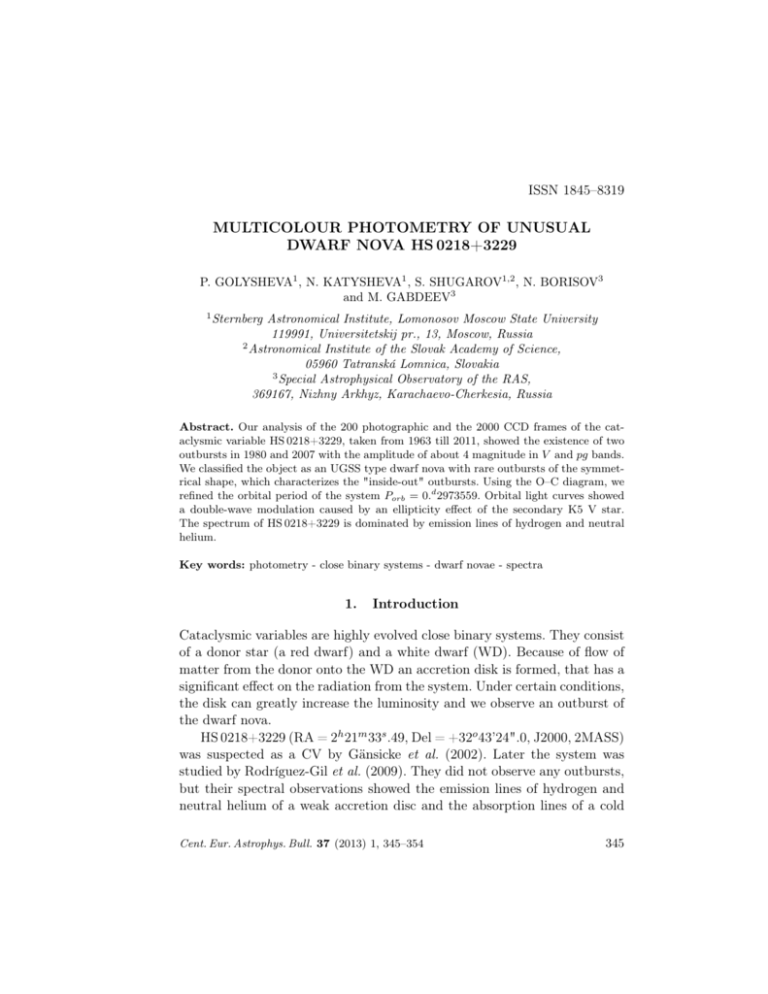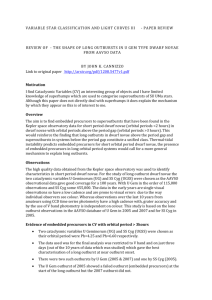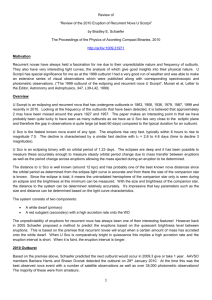multicolour photometry of unusual dwarf nova hs 0218+3229
advertisement

ISSN 1845–8319 MULTICOLOUR PHOTOMETRY OF UNUSUAL DWARF NOVA HS 0218+3229 P. GOLYSHEVA1 , N. KATYSHEVA1 , S. SHUGAROV1,2 , N. BORISOV3 and M. GABDEEV3 1 Sternberg Astronomical Institute, Lomonosov Moscow State University 119991, Universitetskij pr., 13, Moscow, Russia 2 Astronomical Institute of the Slovak Academy of Science, 05960 Tatranská Lomnica, Slovakia 3 Special Astrophysical Observatory of the RAS, 369167, Nizhny Arkhyz, Karachaevo-Cherkesia, Russia Abstract. Our analysis of the 200 photographic and the 2000 CCD frames of the cataclysmic variable HS 0218+3229, taken from 1963 till 2011, showed the existence of two outbursts in 1980 and 2007 with the amplitude of about 4 magnitude in V and pg bands. We classified the object as an UGSS type dwarf nova with rare outbursts of the symmetrical shape, which characterizes the "inside-out" outbursts. Using the O–C diagram, we refined the orbital period of the system Porb = 0.d 2973559. Orbital light curves showed a double-wave modulation caused by an ellipticity effect of the secondary K5 V star. The spectrum of HS 0218+3229 is dominated by emission lines of hydrogen and neutral helium. Key words: photometry - close binary systems - dwarf novae - spectra 1. Introduction Cataclysmic variables are highly evolved close binary systems. They consist of a donor star (a red dwarf) and a white dwarf (WD). Because of flow of matter from the donor onto the WD an accretion disk is formed, that has a significant effect on the radiation from the system. Under certain conditions, the disk can greatly increase the luminosity and we observe an outburst of the dwarf nova. HS 0218+3229 (RA = 2h 21m 33s .49, Del = +32o 43’24".0, J2000, 2MASS) was suspected as a CV by Gänsicke et al. (2002). Later the system was studied by Rodríguez-Gil et al. (2009). They did not observe any outbursts, but their spectral observations showed the emission lines of hydrogen and neutral helium of a weak accretion disc and the absorption lines of a cold Cent. Eur. Astrophys. Bull. 37 (2013) 1, 345–354 345 P. GOLYSHEVA ET AL. component. They described the second component as a K5V star which contributes of 80-85% to the R-brightness of the system. Rodríguez-Gil et al. (2009) determined: the orbital period 0d .297229661 ± 0d .000000001, inclination of the orbit i = 59◦ ± 3◦ , mass ratio 0.52 < q < 0.65, mass of the white dwarf 0.44 < M1 (M⊙ ) < 0.65, mass of the secondary 0.23 < M2 (M⊙ ) < 0.44 and distance to the system of 0.87–1.0 kpc. HS 0218+3229 was also identified as X-ray source RXS J022133.6+324343 and as IR-source 2MASS J02213348+3243239. Independently HS 0218+3229 was discovered and studied by Antipin (see Golysheva et al., 2012). Two outbursts of HS 0218+3229 that occured in 1980 and 2007 yrs were detected. One more outburst (in 2002) was found by P. Wills in the database NEAT1 . 2. Observations The photometric CCD-observations were carried out with the 50-cm telescope in Stará Lesná (Slovakia) and 50- and 125-cm telescopes of the Crimean laboratory of SAI. More than 2000 CCD frames in U BV RC,J IC,J bands at the period from 2006 to 2010 years were received. More detailes about these observations were described in the paper by Golysheva et al. (2012). Two spectra of HS 0218+3229 were taken on September, 17/18, 2010 in the prime focus of the Russian 6-m telescope BTA with the SCORPIO multi-mode focal reducer (Afanasiev and Moiseev, 2005) at the spectroscopic mode with the long slit and CCD-camera EEV CCD 42-40. Spectra were obtained with the exposition 300 sec under satisfactory atmospheric conditions, with S/N = 15. The grating VPHG (1200 lines/mm) provided the spectral resolution 5 Å in the spectral range 4000–7300 Å. For flux calibration and the calibration of the wavelength the star BD+33o 2642 and Ar-Ne-He lamp were observed. Spectra were reduced, sky and bias have been removed and then divided by a flat-field frame. Astronomical data packages in IDL system were used for reduction of the spectral observations. HS 0218+3229 was in its quiescence state. 1 346 NEAT – Near-Earth Asteroid Tracking: http://neat.jpl.nasa.gov/ Cent. Eur. Astrophys. Bull. 37 (2013) 1, 345–354 MULTICOLOUR PHOTOMETRY OF UNUSUAL DWARF NOVA HS 0218+3229 3. Analysis of Photometric Data IC RC V B U HS 0218+3229 was observed during the 70 nights from November 2006 till November 2011. One outburst was found by S. Antipin on the four photo plates from the SAI archive in September 1980. Another outburst was caught in October 2007. Overall U BV RI-light curves obtained in 2006-11 are presented in Figure 1. The detailed V -light curves of the 2007 outburst are shown in Figure 2: the outburst light curve is on the upper figure and the nightly LCs during outburst are in the bottom. The magnitudes of comparison stars from the paper Golysheva et al. (2012) were used for the frame calibration. 12 14 16 12 14 16 12 14 16 12 14 16 12 14 16 54 000 54 200 54 400 54 600 54 800 55 000 55 200 55 400 55 600 JD 2 400 000+ Figure 1: The overall light curves in U BV RI-bands. The observations in RJ , IJ bands are plotted by grey points. The last outburst was fully recorded only in the V -band. We estimated the following stellar magnitudes at the maximum by extrapolation: U ≈11m .3 ± 0m .2 , B≈V ≈12m .3 ± 0m .2, and RJ ≈IJ ≈12m .2 ± 0m .2. Cent. Eur. Astrophys. Bull. 37 (2013) 1, 345–354 347 P. GOLYSHEVA ET AL. These values were used for the estimation of the outburst amplitudes. It was found that the amplitude of the outburst was the highest in the U band: ∼ 5m , in B-band ∼ 4.m 5 and was lower in R and I-bands (∼ 3m and 2.5m , accordingly). The light curve of the 2007 outburst has a more symmetric shape than for most dNe (see Figure 2). The coefficient of asymmetry (the ratio of duration of the rising branch to the duration of all outburst) is 0.22 for our object. The maximum of outburst occurred within the interval JD 2454384– 385. V 12 13 c 14 b d 15 16 a 17 378 380 16.2 382 384 386 388 390 392 13.4 13.6 394 13.85 13.42 16.3 13.9 13.44 13.7 16.4 13.46 a 13.8 16.5 379.4 379.5 b 382.4 382.5 13.48 c 392.4 392.45 392.5 13.95 d 14 393.3 393.4 393.5 JD 2 454 000+ Figure 2: The LC of the 2007 outburst in the V band (top), the nightly LCs during the outburst (bottom). As seen in Figure 2, during the outburst there are no significant shortperiod variations of the brightness, while in the quiescent state periodic oscillations are shown up distinctly. This variability can be explained by the orbital motion of the system. Figure 3 shows the nightly U BV Rc Ij outside the outburst period in 2010. A large UV-excess should be noted. During the outburst the position of the star in the two-color diagram is close to that of an absolute black 348 Cent. Eur. Astrophys. Bull. 37 (2013) 1, 345–354 MULTICOLOUR PHOTOMETRY OF UNUSUAL DWARF NOVA HS 0218+3229 body with a temperature of about 15000 K. At the brightness minimum the position of the variable corresponds to a star of spectral class K5V–K6V. More detailed information about two-color diagrams was given in the paper by Golysheva et al. (2012). An orbital wave with the amplitude of 0m .13 − 0m .19, depending on the spectral band, can be seen in Figure 3. A similar variation of the brightness has been observed by Rodríguez-Gil et al. (2009) also. It should be noted that they made their observations with a clear filter. They showed that the brightness of the star varied with a period 0.d 297229661. IJ RC V B U 2010 Nov 14 2010 Nov 15 2010 Nov 16 15 15 15 16 16 16 17 17 17 16 16.5 17 17.5 16 16.5 17 17.5 16 16.5 17 17.5 15.5 15.5 15.5 16 16 16 16.5 16.5 16.5 15 15 15 15.5 15.5 15.5 16 16 16 14 14 14 14.5 14.5 14.5 15 15.2 15.3 15.4 JD 2 455 500+ 15 16.2 16.3 16.4 JD 2 455 500+ 15 17.3 17.4 17.5 JD 2 455 500+ Figure 3: The nightly U BV Rc Ij (from top to bottom)light curves of 14th , 15th and 16th November 2010. We investigated our light curves and concluded that during the orbital period there was a double wave. The double wave over the period is related to a distorted shape (an ellipsoidal surface of the Roche lobe) of the cold component. A rapid variation in the brightness unrelated to the orbital wave can be seen in the U and B-bands in Figure 3. This variability has a characteristic time of ∼40–50 min and in the U -band the observed maximum amplitude of the rapid variability is up to 0m .7. In the B-band the amplitude is somewhat less at 0m .4. We assume that this flickering is related to the hottest component of the system, i.e. the fluctuations of the hot region Cent. Eur. Astrophys. Bull. 37 (2013) 1, 345–354 349 P. GOLYSHEVA ET AL. where the stream interacts with the accretion disk. In the paper by Golysheva et al. (2012) it was shown that orbital double wave changed during the October 2007 outburst. While the amplitudes of the humps before the outburst were different, after the outburst they became similar. Using the observations of minima from Rodriguez-Gil et al. (2009) and our data, we determined more precise value of the orbital period from O–C diagram (Table I) and got the orbital ephemeris: JDmin hel = 2453653.0286 + 0.d 2973559 · E, where T0 = 2453653.0286 was taken from Rodriguez-Gil et al. (2009). In Table I the times of minima for JD< 2453656 were taken from Rodríguez-Gil et al. (2009), later dates – our observations, uncertain data are marked by ":". The O–C diagram is plotted in Figure 4. It consists of two parts, corresponding to the main (left) and the secondary (right) minima. Figure 4: The O–C diagrams for the main minima (left) and the secondary minima (right). The summed light curves, folded with the determined period, are plotted in Figure 5. The double wave per a period is clearly seen, especially in V and Rc -bands. In the U and B-bands the double wave is not so obvious but there is some fading at phase 0. It can be seen from the orbital curves, a brightness minimum (and reddening) sets at times when the secondary component is visible from the side of the "nose" (ϕ = 0.5) or from the trailing side (ϕ = 0.0) (see Figure 5). 350 Cent. Eur. Astrophys. Bull. 37 (2013) 1, 345–354 MULTICOLOUR PHOTOMETRY OF UNUSUAL DWARF NOVA HS 0218+3229 Table I: Minima times of HS 0218+3229 at phases 0 and 0.5. HJD 51926.274 51956.305 53653.029 53653.918 53654.809 53655.704 54117.220 54141.293 54379.469 54709.542 54758.611 54759.498 54843.349 55076.476 55463.325 55473.434 55476.417 55480.290 55480.581 55481.475 55482.647: 55483.550 55515.359 55516.253 E, cycle -5807 -5706 0 3 6 9 1561 1642 2443 3553 3718 3721 4003 4787 6088 6122 6132 6145 6146 6149 6153 6156 6263 6266 O–C -0.005 -0.007 0.000 -0.003 -0.004 -0.001 0.018 0.005 -0.001 0.006 0.011 0.006 0.002 0.002 -0.010 -0.011 -0.002 0.006 -0.001 0.001 -0.016 -0.005 -0.013 -0.011 HJD 51918.399 51926.427 52576.445 52577.337 53652.882 53653.774 53654.674 53654.959 53655.855 54066.502 54067.400 54076.319 54122.390: 54710.581: 54751.610 54828.330 54845.268: 55052.524: 55071.560 55082.566: 55211.340: 55473.310: 55473.598 55476.579: 55480.435 55481.324 55481.629: 55482.507: 55484.589 55517.310 Cent. Eur. Astrophys. Bull. 37 (2013) 1, 345–354 E, cycle O–C -5833.5 -5806.5 -3620.5 -3617.5 -0.5 2.5 5.5 6.5 9.5 1390.5 1393.5 1423.5 1578.5 3556.5 3694.5 3952.5 4009.5 4706.5 4770.5 4807.5 5240.5 6121.5 6122.5 6132.5 6145.5 6148.5 6149.5 6152.5 6159.5 6269.5 -0.001 -0.001 -0.004 -0.004 0.002 0.002 0.001 -0.002 0.001 -0.001 0.005 0.003 -0.016 0.004 -0.002 0.000 -0.011 -0.013 -0.008 -0.004 0.015 0.014 0.004 0.012 0.002 -0.001 0.007 -0.007 -0.007 0.005 351 P. GOLYSHEVA ET AL. The phased color-indices curves of the main and secondary minima differ slightly. An interpretation of these variations was made in Golysheva et al. (2012). 16 RC U 15.4 16.2 15.6 15.8 16.4 14.4 16.8 IJ B 14.6 17 14.8 17.2 15 14.6 16 14.8 V IC 16.2 16.4 15 15.2 16.6 ϕ 0 0.5 ϕ 1 1.5 Figure 5: The phased light curves. 4. Spectroscopic Observations The spectrum of HS 0218+3229 was obtained at the 6-m telescope BTA with the SCORPIO multi-mode focal reducer. Emission Balmer lines (Hα , Hβ , Hγ , Hδ and higher lines) and emissions of neutral helium λλ 4471, 4921, 5015, 5875, 6678, 7065 Å are present in the spectrum. The flux (erg/s/cm2 ) versus wavelength is plotted in Figure 6. Balmer emissions are not bifurcated, helium lines are more complex. The form of the spectrum of September 2010 is very different from the spectrum obtained by Rodriguez-Gil et al. (2009). Emission lines of neutral helium λ 5875 Å became stronger. The humps of the red companion became less pronounced and emission Balmer decrement more flat. 352 Cent. Eur. Astrophys. Bull. 37 (2013) 1, 345–354 MULTICOLOUR PHOTOMETRY OF UNUSUAL DWARF NOVA HS 0218+3229 Figure 6: Spectrum of HS 0218+3229. We can propose that the rate of mass transfer on the 17-18th of September 2010 was larger than on the 28-29th of October 2002. The spectrum became bluer and filled the spectrum of the secondary component. 5. Summary 1. We classified HS 0218+3229 as a rare subtype of dwarf novae (UGSS) with a more symmetric form of outburst (with a asymmetry coefficient 0.22 instead of 0.10 for most of such stars). It could be explained by a critical density of mater that is initially attained in the inner parts of the disk, after which the outburst propagates toward its outer parts (a so-called "insideout outburst" , see Smak (1984), Cannizzo et al. (1986)). The instability develops in the inner, rather than outer, parts of the disk at low accretion rates, Ṁ < 10−10 M⊙ /year, since it is in just this case that matter is able to reach the inner parts of the disk and accumulate there. Thus, given the symmetry of the light curve of an outburst, we may conclude that Ṁ is small. The same result follows from an estimate of the luminosity of the accretion disk and the red component (see Golysheva et al., 2012). 2. The outburst amplitude changes from 5m in the U -band to 2m .5 in the I-band. 3. Using the O–C diagrams we refined the orbital period and got the ephemeris JDminhel = 2453653.0286 + 0.d 2973559 · E. Cent. Eur. Astrophys. Bull. 37 (2013) 1, 345–354 353 P. GOLYSHEVA ET AL. 4. The form of the spectrum of September 2010 is very different from the spectrum obtained by Rodriguez-Gil et al. (2009). The emission lines of neutral helium λ 5875 Å became stronger. The humps of the red companion became less pronounced and the emission Balmer decrement more flat. 5. At quiescence there is a small variability with an amplitude of 0m .2 and with a characteristic time of hundreds of days (See Golysheva et al., 2012). Note, that in Golysheva et al. (2012) some parameters of the system were estimated and compared with the parameters derived by Rodriguez-Gil et al. (2009). But, there are still some unsolved problems: – recurrent time between outbursts is unknown; – the variability in U and B-bands connecting with the instability of accretion disk; – a long-term periodicity, associated with solar-like activity of the secondary is poorly studied. Acknowledgements This work is partially based on observational data obtained with the 6m telescope BTA of the SAO RAS. PG is grateful to the LOC and the SOC and RFBR grant 12-02-00186 for financial support. This work was partially supported by grants: VEGA-grant 2/0038/10, NSh-2374.2012.2, RFBR 11-02-00495, RFBR 11-02-01213. NK is thankful for support from SAIA (Slovakia) References Afanasiev, V. and Moiseev, A.: 2005, Astron. Lett. 31 194. Cannizzo, J. K., Wheeler, J. C., and Polidan, R. S.: 1986, Astrophys. J. 333, 227. Gänsicke, B. T., Beuermann, K., and Reinsch, K.: 2002, ASP Conf. Ser. 261, 190. Golysheva, P. Yu., Antipin, S. V., Zharova, A. V., Katysheva, N. A., Chochol, D., and Shugarov, S. Yu.: 2012, Astrophysics 55, 2. Rodríguez-Gil, P., Torres, M. A. P., Gänsicke, B. T., Muñoz-Darias, T., Steeghs, D., Schwarz, R., Rau, A., and Hagen, H. -J.: 2009, Astron. Astrophys. 496, 805. Smak, J.: 1984, Acta. Astron. 35, 357. 354 Cent. Eur. Astrophys. Bull. 37 (2013) 1, 345–354







